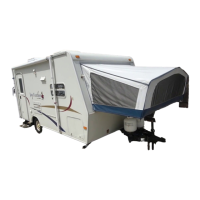SAFETY
IN
USING
L.P.
GAS
You should check for leaks at the
connections on the LP.-gas
system soon after purchase and initial filling of L.P.-tanks, and
continued periodic checks of the system are recommended. Your
vehicle was manufactured to provide you with full access to
all
gas line connections. Leaks can be found with a soapy water
solution applied
to
the outside of the
gas
piping connections: the
soap will bubble
at
the leak.
DO
NOT
USE
FLAME
OR
LIGHTED
TCmS
TO
TEST
FOR
LEAKS.
Usually tightening of
connections
will
close leaks.
If
not,
ask
your authorized dealer
service department to
make
the necessary repairs.
EVEN
THOUGH
THE
MANUFACTURER
AND
DEALER HAVE
ALREADY
MADE
TESTS
FOR
LEAKAGE.,
THIS
CHECK
IS
ADVISABLE
BECAUSE
OF
THE
VIBRATION
ENCOUNTERED
DURING
TRAVEL.
L.P.-gas is heavier than air. Leaking gas tends to flow to low
places. It will sometimes pocket in
a
low area, L.P.-gas can
usually
be
detected by
an
identifiable odor similar to onions or
garlic. Never light a match or allow
any
open flame in the
presence of leaking gas.
It
is
very important to have L.P.-gas shut off during refueling of
tow vehicles.
Some
states prohibit
gas
appliances to be operated
during travel, especially in any underground tunnels.
Never allow gas containers to be filled above the liquid capacity
indicated on
the
container.
If
a container
is
overfilled, liquid
gas
may flow through the regulator causing
it
to freeze and/or
introduce
a
dangerous excessive gas pressure into the lines.
In
addition, an overfilled container placed in hot sunlight may expel
excess
gas
through the relief valve and be susceptible to ignition
by any nearby open flame.
ELECTRICAL
SYSTEM
SAFETY
Circuit breakers and fuses are installed to protect electrical circuits
from overloading.
Do
not make unauthorized changes to circuitry
or add
on
fixed appliance yourself.
If
you
wish
changes, consult
your dealer and he will assist you
in
obtaining a safe installation.
An
approved power supply cord has been supplied
with
the
vehicle. Always use this
cord
for hook-up to the 120-volt source.
Note that the cord has
a
three pin plug, which provides proper
grounding through the third (round) pin,

